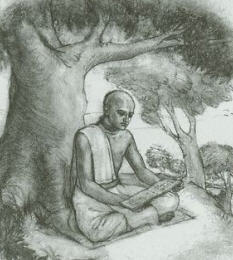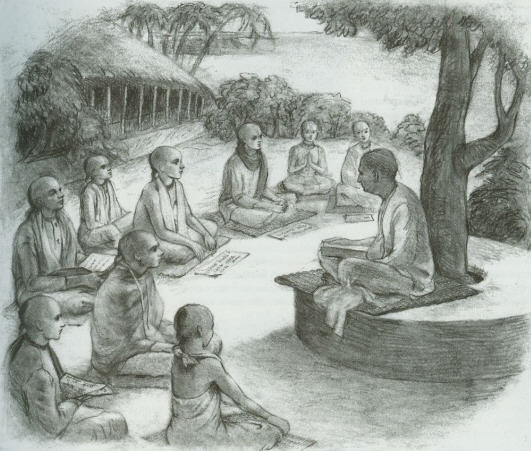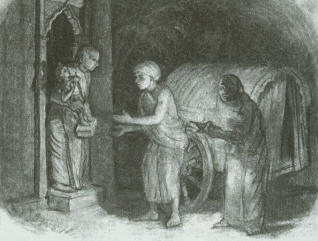The Gaudiya Vedantist

Baladev Vidyabhusana
THEIR VOICES ROSE with the sun. It was early morning in an Indian village school. The boys sat in neat rows behind palm-leaf manuscripts, committing their lessons to memory. As they chanted their grammar rules, their rhetoric lessons, and their logic aphorisms, each boy chanted loud enough to hear himself over his neighbor, resulting in a blend of high-pitched voices.
This school, attended by Baladeva early in the eighteenth century, closely resembled village schools that had existed in India for thousands of years. The system had endured because it was effective, producing brilliant and disciplined scholars, and Baladeva was among the best of them.
Before coming to school, Baladeva, the son of a merchant, had lived for several years near the Orissan town of Remuna. From there he had gone to study with the group of panditas at this school, situated idyllically on the bank of the Cilkahrada River. The lush Orissan forests and fertile fields provided ample fruits, vegetables, and grains for a wholesome, varied diet. The boys studied hard, played hard, and grew lean, healthy, and discerning.
When Baladeva graduated from school, he did not want to return home to work in his father's shop. He wanted to be a scholar—not an ordinary scholar but a true acarya, one who could teach divine wisdom. A pandita had to master logic, philosophy, medicine, or cosmology, but an acarya had to know the scriptures that impart the deepest wisdom. Baladeva decided to study philosophy and theology. He would become a Vedantist, an authority on the ancient Vedic books of knowledge. He could not think of any greater way to benefit himself or others.
In search of a preceptor, Baladeva went on pilgrimage to the tirthas (holy places), where he would meet monks and scholars. In Mysore (now Karnataka), in southwestern India, he came upon a hermitage of holy men who were also called Tirthas, followers of the saint and scholar Ananda Tirtha (A.D. 1197-1273), who was known formally as Madhva Acarya. In the monastery, or matha, Baladeva studied Vedanta and mastered the arts of debate and rhetoric. These talents would serve him well in a challenge he would later face while still a young man.
The challenge Baladeva would meet is of critical importance to the history of Gaudiya Vaisnavism, the spiritual school to which the modern-day Krsna consciousness movement belongs.
The Gaudiyas in Vrndavana

Teachings of Lord Chaitanya
By the time Baladeva was born, the Gaudiya Vaisnavas, or followers of Lord Caitanya Mahaprabhu, were well established in Vrndavana, the town in northern India where Lord Krsna had enacted His childhood pastimes some five thousand years earlier. But life in that area was often insecure. For thousands of years the Vrndavana-Mathura district had been periodically invaded and pillaged. Yet despite these calamities, Mathura had thrived as a center of trade and culture. Every ancient religion of northern India considered Mathura an important city.
In 1512 Lord Caitanya arrived in Mathura. He found that the places where Krsna had enjoyed pastimes were now obscured, so he spent two months locating and identifying them. Wanting to reconstruct Vrndavana and rededicate it to Krsna, He sent Rupa Gosvami and Sanatana Gosvami, two of His chief disciples, to the holy city.
Rupa Gosvami and Sanatana Gosvami accomplished Lord Caitanya's mission in Vrndavana. Not only did they rebuild the sacred places of Krsna's life, but they also wrote books that presented Lord Caitanya's doctrine in a way suitable for both scholars and laymen. Srila Jiva Gosvami, their nephew and disciple, continued their work. He supervised the construction of magnificent temples for the worship of Krsna, wrote exhaustive philosophical treatises on the philosophy of Krsna consciousness, and distributed the religious manuscripts of the Vrndavana Gosvamis throughout the Vaisnava world. Largely due to Jiva Gosvami's efforts, the Gaudiya Vaisnavas succeeded in establishing Vrndavana as the principal seat of Vaisnavism in northern India.
Vrndavana had always been a holy pilgrimage site, but under Gaudiya patronage it flourished as a powerful religious center for 150 years. Gaudiya gurus and temples held sway in Vrndavana, even at the time of Baladeva's arrival in the early eighteenth century.
Govinda Leaves Vrndavana
Unfortunately, the peaceful leadership of the Gaudiyas could not last. In 1669 the Mogul ruler Aurangzeb decreed that Hindu temples and carved images, or Deities, should be destroyed. Deities, priests, and pilgrims were in danger, and faithful devotees of Krsna stopped visiting Vrndavana. Many of those who had the courage to express their faith were beaten or killed.

Deity at Radha Kunda
Subsequently, the Vaisnava priests appealed to the Hindu dynasties of Rajasthan for protection for themselves and their Deities. Protection was guaranteed, and gradually the Deities migrated east, to settle in Mewar and in Amber, the old Jaipur capital. But without Deities, brahmanas, and pilgrims, Vrndavana-Mathura lost much of its glory.
One of the principal Deities of Vrndavana was Govinda, a twenty-four-inch black marble image of Krsna in His original aspect as a cowherd boy. Srila Rupa Gosvami had found Him while excavating the holy places of Vrndavana. Later, warned that Aurangzeb's army would seek to demolish Govinda's splendid seven-story temple, the priests secretly moved the Deity to Radha-kunda, a sacred pond widely known as one of the holiest places in the Mathura district.
After a year at Radha-kunda, the priests transferred their divine refugee to Kaman, a fortified city in the Mathura district, where a suitable complex could be built for Govinda. For more than thirty years He and two other Deities, Gopinatha and Madana-mohana, remained in Kaman. But most pilgrims avoided the ruling Moguls and a clan of local people called the Jats, who had risen up against the Moguls.
The Rajput kings of Amber found themselves at the pivot of the conflict between the Moguls and the Jat guerrillas. The kings allied them-selves with the Moguls against the Jats but patronized the Vrndavana Deities, whom the Moguls wanted to destroy.
Ram Singh, the king of Amber, had ordered in 1671 that Govinda be transferred to Kaman, which was then under the jurisdiction of Amber and Jaipur although it was in the Mathura district. It is said that the transfer was meant to be temporary: the Deity would return to Vrndavana when the political turmoil subsided. But Govinda did not return to Vrndavana. After thirty-three years in Kaman, He made another trip, this time to Amber.
Ram Singh had died and been followed quickly to the next life by his son, Visnu Singh. Now there sat on the throne of Amber a child-king, a precocious eleven-year-old named Jai Singh, who had been decorated in the Mogul court at Agra at the age of seven. Under the rule of Jai Singh, Govinda was transferred in 1707 to a village called Govinda-pura, just outside Amber.
The Ramanandis' Challenge
Govinda's new home had little in common with the forest of Vrndavana, where he had lived so grandly. In Vrndavana, a Vaisnava holy place, Govinda was the unchallenged Supreme Lord. His priest, who stood in the direct line of Rupa Gosvami, the acknowledged leader of the Vaisnavas in Vrndavana, had enjoyed unchallenged authority on questions about the philosophy and practice of bhakti, devotional service to Krsna.
In Amber, however, not all the Vaisnavas worshiped Krsna. During the reign of Prthviraj Singh (1503-1527), a devotee of Lord Ramacandra named Payahari Krsnadasa had settled in Galta, a valley near the present-day city of Jaipur. Payahari was a grand-disciple of Ramananda, the fourteenth-century North Indian reformer of the South Indian Vaisnava sampradaya (lineage) of Ramanuja. Payahari worshiped Sita-Rama, not Radha-Krsna.
Payahari had settled in a cave in the Galta valley. He had converted Queen Balan Bai to Ramanandi Vaisnavism, and she in turn had convinced her saintly husband, King Prthviraj, to sponsor the establish-ment of a Ramanandi monastery in Galta. Thereafter, Galta had become the northern headquarters for the Ramanuja sect.
For six generations the Ramanandi mahantas (temple heads) had enjoyed a privileged position in the Amber kingdom. But Govinda's arrival in Amber and His popularity with the royal family challenged the Ramanandi hegemony.
To Jai Singh the arrival of Govinda was especially significant. Despite the presence of many Hindu sects in his kingdom, despite his own royal obligations to maintain Vedic and Puranic ritual sacrifices, and despite the unchallengeable authority of the Ramanandi priests, Jai Singh was ultimately a devotee of Govinda. The arrival of Govinda in his kingdom was a high point in his personal spiritual quest.
The Ramanandi priests soon realized that if Govinda became the favored Deity of the king, the Gaudiya priests would assume religious authority in Amber. What would become of the Ramanandis' ascendancy?
The Ramanandis then approached Jai Singh with a complaint about the Gaudiyas. They questioned the Gaudiya lineage. In India, much is made of one's parentage. If one cannot prove natal legitimacy, one may be cast out as a bastard. The same social standard applies to religious organizations. If a religious group cannot prove its descent from one of the recognized traditions, it risks being dismissed as illegitimate.
Jai Singh wrote to the mahanta of the Gopinatha temple, Syamcaran Sarma, asking him to clarify the matter by explaining the lineage of the Gaudiya devotees. Syamcaran replied with a letter in Sanskrit, quoting various scriptures and other authorities. He explained that the Gaudiya lineage had begun with Lord Caitanya, who was the Supreme Godhead. After all, a spiritual lineage originating with God is unassailable.
Predictably, the Ramanandis were not satisfied. They said, "There are only four sampradayas, not five. Scholars have ascertained this on the basis of the Padma Purana."
It is here that our story brings us back to Baladeva.
The Nurturing of Baladeva
Before the Ramanandis had complained in Amber, young Baladeva, living in Mysore, had been instructed in the Vedanta-sutra by the followers of the great Vedantist Madhva Acarya.
The word vedanta consists of two words: veda ("knowledge") and anta ("end"). So Vedanta is the culmination of Vedic knowledge. The Vedas are the oldest of the traditional Sanskrit writings compiled by Srila Vyasadeva. Vyasadeva later composed the Vedanta-sutra, which contains in terse codes the essence of the Upanisads (the philosophical hymns of the Vedas). Because the Vedanta-sutra is written in aphorisms, one needs a commentary to understand it. The oldest and most famous extant commentary is that of Sankara Acarya (A.D. 788-820).
Sankara was a monist; he believed in the ultimate oneness of the jiva (living being) and God, and he interpreted the Vedanta-sutra accordingly. After Sankara, four learned Vaisnavas stepped forward over the course of several hundred years to writeVedanta-sutra commentaries. These Vaisnavas wrote to establish the duality of the jiva and God and thus refute the monistic teaching of Sankara.
These four Vaisnava preceptors—Sri Ramanuja Acarya, Sri Nimbarka, Sri Madhva Acarya, and Sri Visnusvami—established the four acknowledged Vaisnava sampradayas. Subsequent Vaisnava religious leaders belonged to one of thesesampradayas and were thus considered legitimate. Ramananda claimed that his lineage originated with Ramanuja.
We recall again that Baladeva, in Mysore, had stayed in a matha of the Madhva-sampradaya and studied the Vedanta-sutra commentary of Madhva.
He had enjoyed his education, but he enjoyed even more the application of his learning. He was exhilarated by debates; no challenge was too great for him. And he was eager for the opportunity to enlighten others. Now, after becoming a skilled lecturer and debater, Baladeva left Mysore and went to Puri, in Orissa, where he again took up residence in a Madhva matha.
At Puri, Baladeva met Radhadamodara Dasa, a brahmana from Kanyakubja (now Kanpur), in north central India. Radhadamodara was the grand-disciple of Rasikananda, a seventeenth-century preacher who had established the Gaudiya movement throughout Orissa. Radhadamodara, a scholar of Gaudiya philosophy, explained to Baladeva the position of Lord Caitanya, supporting his points with quotations from Mahabharata and Srimad-Bhagavatam.
Radhadamodara said, "Sri Krsna Caitanya is the Supreme Godhead Himself. He came to flood the world with krsna-prema, love of Krsna. Sri Caitanya was not interested in the study of many commentaries on Vedanta-sutra, for He consideredSrimad-Bhagavatam, written by the same author—Vyasa—to be the natural commentary. So from the Bhagavatam and by His own example, He taught that we must serve the Supreme Lord, Krsna, and absorb ourselves in hearing about Him and glorifying Him. Sri Caitanya Himself was always absorbed in krsna-prema. Thus He saw no need to write any books."
Radhadamodara advised Baladeva to study the Bhagavata-sandarbha, by Srila Jiva Gosvami. For days Radhadamodara and Baladeva met and discussed Jiva's work. Baladeva noted that Jiva did not significantly differ from Madhva. Indeed, the philosophies of Jiva and Madhva agreed on most essential points. Still, Jiva's treatise developed Vaisnava philosophy in an elegant and logical way that deeply impressed Baladeva.
Now convinced that the Gaudiya perspective was true, Baladeva asked Radhadamodara to initiate him into the Gaudiya-sampradaya. Baladeva, however, was already an initiated Vaisnava, so Radhadamodara performed not a formal initiation but a ceremony in which Baladeva agreed to accept and serve Sri Caitanya Mahaprabhu as the Supreme Lord. Thus Baladeva became a member of the Gaudiya sampradaya.
Mastering Gaudiya Philosophy
Baladeva then decided to travel to Vrndavana, the spiritual center of the Gaudiya sect. But first he went to Navadvipa, where he met the Vaisnavas there and discussed philosophy with them. They all told him to study under Visvanatha Cakravarti Thakura in Vrndavana. Because Baladeva was so eager to meet Visvanatha, he stayed only a short time in Navadvipa before setting out on foot to travel the eight hundred miles to Vrndavana.
Arriving in Vrndavana, Baladeva soon met Visvanatha Cakravarti, introduced himself, and explained his background and the story of his meeting with Radhadamodara in Puri. Visvanatha was gratified that Baladeva had come to study Srimad-Bhagavatam, and he suggested a suitable day for them to begin their studies. He also decided that Baladeva should study the rasa-sastras, texts of advanced devotion, with another scholar, Pitambara Dasa.
Baladeva's appetite had been whetted by reading Jiva Gosvami's Bhagavata-sandarbha in Puri. From Pitambara, Baladeva learned the esoteric meaning of the bhagavata philosophy, as found in the rasa-sastras. He then studied the Caitanya-caritamrta, Krsnadasa Kaviraja Gosvami's biography of Lord Caitanya. The Caitanya-caritamrta is an advanced text for those who have fully studied the other Vaisnava scriptures. By completing his study of this culminating work, Baladeva qualified himself for a brilliant future as a Gaudiya scholar.
Meanwhile, in Amber the Ramanandis continued to wage ideological war against the Gaudiyas. The Ramanandis did not accept the answer that the Gaudiya mahantas had given to King Jai Singh—that Sri Caitanya Mahaprabhu was the Supreme Lord Himself and that his sampradaya was therefore beyond doubt. The Ramanandis insisted on the principle of sampradaya catvarah, "there are only four sampradayas," implying, of course, that the Gaudiyas constituted an unauthorized fifth lineage.
In the next issue of BTG, Baladeva defends Gaudiya Vaisnavism against the charges of the Ramanandis.
Dayananda Dasa and Nandarani Devi Dasi joined the Hare Krsna movement in 1967 in San Francisco. Soon afterward Srila Prabhupada performed their Vedic marriage ceremony and sent them to Los Angeles to open the first Hare Krsna temple there.
In 1971 they traveled to London, where Dayananda served as the temple president. From '73 to '75 he was the headmaster at the gurukula (Hare Krsna school) in Dallas, and from '76 to '79 he and Nandarani taught Krsna consciousness in Iran. From 1982 to '84 they helped oversee the Krsna center in Washington, D.C., and since then they have been working with the Institute for Vaisnava Studies, located near Washington, D.C. The Institute researches Vaisnava thought, history, and practice.
References
Jiva Goswami's Tattvasandarbha, Stuart Mark Elkman (Elkman's commentary includes Bhaktivinoda Thakura's comments on Baladeva Vidyabhusana), Motilal Benarsidass, 1986.
Sri Sri Gaudiya Vaisnava Abhidana, Sri Haridas Das, Haribol Kutir, Sri Dhama Navadvipa, 1955.
History and Culture of the Indian People, Vol. VII, R. C. Majumdar and others, Bharatiya Vidya Bhavan, Bombay, 1974.
Mathura, A District Memoir, Frederick S. Growse, Oudh Government Press, Allahabad, 1883.
Literary Heritage of the Rulers of Amber and Jaipura, Gopal Narayana Bahura, City Palace Museum, Jaipura, 1976.
Jaipur City, A. K. Roy, (publisher and date unknown).
